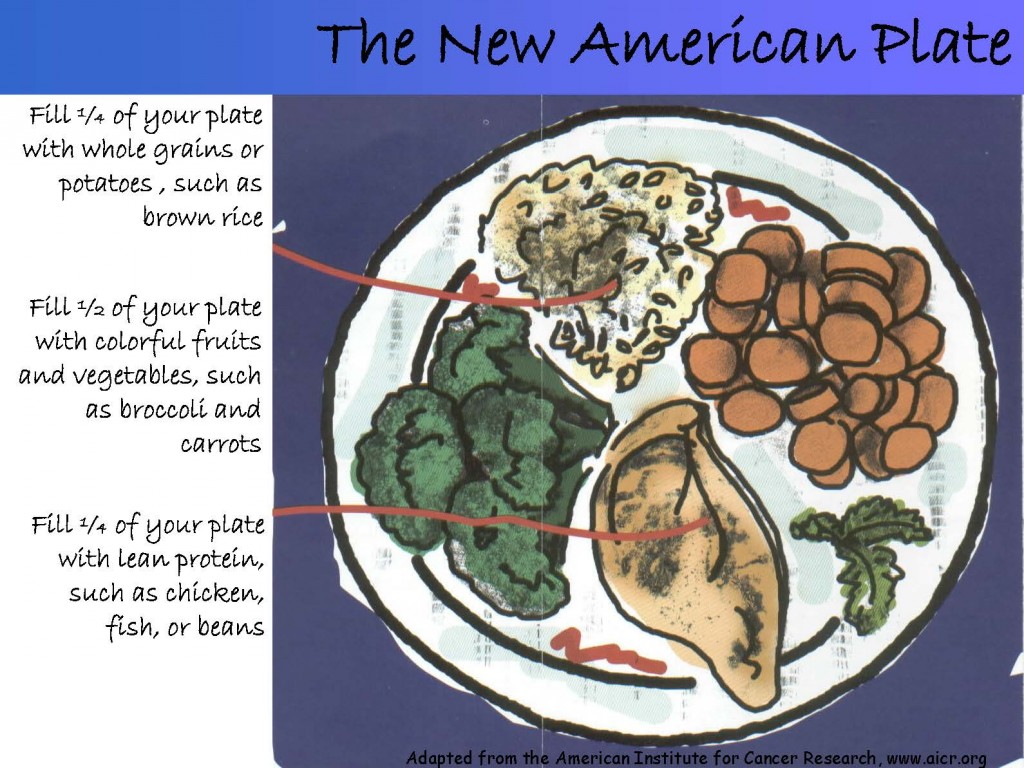Paleo, vegan, low carb, low fat… with all of the diet buzz, it is easy to get confused about how to eat a healthy diet.
For over ten years, I have used a plate-based approach to guide food intake. Simply fill half of your plate with vegetables and/or fruits, one quarter with whole grains or potatoes, and one quarter with a source of lean protein (beans, fish, poultry, low-fat dairy, etc.) This plate-based approach has also been advocated by the American Diabetes Association, American Institute for Cancer Research (where we have adapted the graphic above), United States Department of Agriculture, and Harvard School of Public Health.
Because the foods that fill that plate are low-energy density, you should feel full before you overconsume calories. So there is no need to count every calorie or weigh every portion of food. Simply fill your plate in the appropriate proportions and stop eating when you are no longer hungry.
Four years ago, the Furman University Department of Health Sciences began a dietary intervention to test the effects of this newly named “FUEL Plate.” Over 100 Furman faculty, staff, and spouses have learned how to adapt their meals and have tracked their progress over time.
The results have been remarkable:
- Weight loss occurs without deprivation. Individuals who follow the FUEL plate for 14-21 meals per week (2-3 per day) tend to lose about 1/2- 1 pound per week without counting calories or feeling deprived with miniscule portion sizes.
- Blood markers associated with chronic disease improve. FUEL participants have experienced reductions in low density lipoproteins (up to 90 mg/dL), triglycerides (up to 150 mg/dL), blood pressure, blood glucose, hemoglobin A1c (up to 4%), and C-reactive protein (inflammatory marker). These improvements help to reduce the risk of cardiovascular disease, type 2 diabetes, and other chronic diseases.
- The need for certain medications decreases. Several participants have been able to reduce or eliminate prescription medications for cholesterol, blood pressure, triglycerides, and insulin resistance while under the care of their health care providers.
- Body composition improves. FUEL participants receive state-of-the-art body composition analysis via Dual Energy X-Ray Absorptiometery (DEXA). The DEXA is a low dose x-ray that analyzes the muscle, fat, and bone in each section of the body. It is the most comprehensive and accurate body composition assessment tool available. Because FUEL participants strive for a moderate calorie deficit, they maximize fat loss and minimize muscle loss. Participants lose total body fat (up to 4%) and abdominal fat when they adhere to the plate.
- Resistance training preserves muscle. An effective exercise program, particularly resistance training, helps to preserve muscle mass that is usually lost when dieting. FUEL participants who performed an effective resistance training program 2-3 times per week for 20-30 minutes preserved more lean muscle than those who only changed their dietary habits. Lean mass affects resting metabolic rate and facilitates lifelong weight management.
- Nutrient intake improves. Because FUEL is a balanced plate filled with nutrient-dense foods, many dietary deficiencies, excesses, and imbalances improve. Three day food record analyses indicate decreased intake of total calories, fat, trans fat, saturated fat, cholesterol, and sodium; increased intake of many nutrients such as vitamin A, vitamin C, folate, potassium, and fibers.

